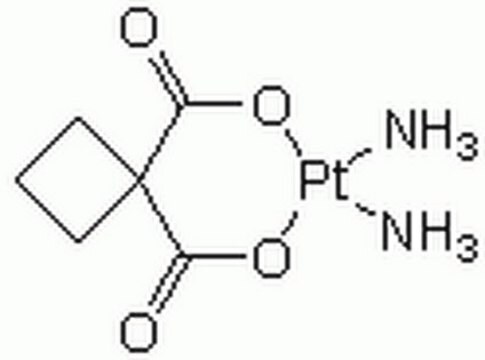BP809
Cisplatin
British Pharmacopoeia (BP) Reference Standard
Sinónimos:
cis-Diammineplatinum(II) dichloride, cis-Dichlorodiammine platinum(II), cis-Platinum(II) diammine dichloride, Cisplatin
About This Item
Productos recomendados
grade
pharmaceutical primary standard
API family
cisplatin
form
solid
shelf life
limited shelf life, expiry date on the label
manufacturer/tradename
BP
mp
270 °C (lit.)
application(s)
pharmaceutical
pharmaceutical small molecule
format
neat
storage temp.
2-8°C
SMILES string
N.N.Cl[Pt]Cl
InChI
1S/2ClH.2H3N.Pt/h2*1H;2*1H3;/q;;;;+2/p-2
InChI key
LXZZYRPGZAFOLE-UHFFFAOYSA-L
¿Está buscando productos similares? Visita Guía de comparación de productos
General description
Application
Also used in monographs such as:
Biochem/physiol Actions
Packaging
Other Notes
Related product
signalword
Danger
Hazard Classifications
Acute Tox. 2 Oral - Carc. 1B - Eye Irrit. 2 - Resp. Sens. 1 - Skin Irrit. 2 - Skin Sens. 1 - STOT SE 3
target_organs
Respiratory system
Storage Class
6.1A - Combustible acute toxic Cat. 1 and 2 / very toxic hazardous materials
wgk_germany
WGK 3
flash_point_f
Not applicable
flash_point_c
Not applicable
Elija entre una de las versiones más recientes:
Certificados de análisis (COA)
Lo sentimos, en este momento no disponemos de COAs para este producto en línea.
Si necesita más asistencia, póngase en contacto con Atención al cliente
¿Ya tiene este producto?
Encuentre la documentación para los productos que ha comprado recientemente en la Biblioteca de documentos.
Los clientes también vieron
Nuestro equipo de científicos tiene experiencia en todas las áreas de investigación: Ciencias de la vida, Ciencia de los materiales, Síntesis química, Cromatografía, Analítica y muchas otras.
Póngase en contacto con el Servicio técnico











